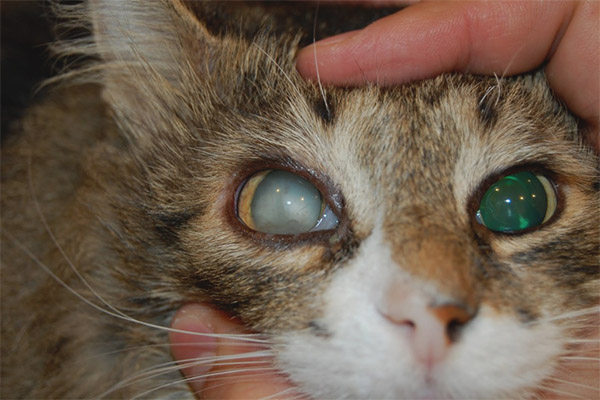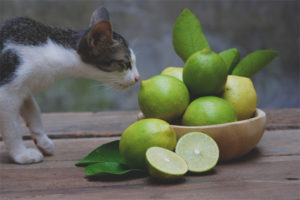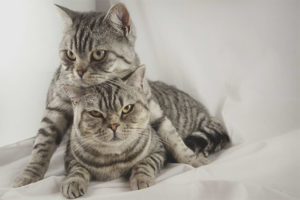The content of the article
Cats are famous for their ability to see in the dark; this is not surprising, since baleen friends are by nature predators. If you do not promptly contact the veterinarian, there is a chance of complete loss of vision in a four-legged pet. Today we will examine the causes of this phenomenon, as well as highlight the possible therapeutic techniques and diagnostic methods.
Causes of blurred eyes
If we consider the issue from a veterinary point of view, experts divide all the reasons into several groups. They may be congenital, acquired or temporary. The last option is the most benign, but often the cat must be taken to the vet immediately.
- The eye cornea can be damaged if the animal has recently suffered an infection or has been exposed to mechanical stress. The eye becomes cloudy due to degenerative phenomena, the presence of scarring.
- Problems with visual organs occur due to impaired fluid exchange in the cavity of the eyeball. As a rule, this is observed during or immediately after infection in an animal. Difficulties are caused by impaired metabolism, poisoning by toxins or food, as well as treatment of a cat with drugs not prescribed by a doctor.
- In the process of forming a cataract the lens is bleached or becomes cloudy. This disease must be treated at the stage of occurrence.
- When ulcers appear on the cornea, the eyeball becomes cloudy. These ulcers appear because of a previous infection, a recent poisoning of an animal with toxins or rat poison, other chemicals. Any irritant that causes intoxication may adversely affect eye health.
- Cannot be excluded from the potential and underlying causes of vitreous disease. When pathogenic microorganisms develop in the cavity or fluid balance is disturbed, the eyes become cloudy.
- In veterinary medicine there are more common causes of what is happening. In practice, cats develop cloudy eyeball due to eyelid defects such as congenitalcharacter, and acquired. Perhaps, he got into a fight with his brothers or was already born with such a disease.
- If surgery was performed relatively recently, that is, an operation was performed on the animal's eyes, then complications are possible. They develop when during the operation a tear duct was damaged or an infection was introduced. This reason comes from the inexperience of the surgeon.
- Opacification causes inflammation of the cornea, that is, keratitis in its various manifestations. Since with this disease the protective layer of the eye is destroyed.
- If an animal has a slow metabolism and an infectious disease, lipids can accumulate in the tissues of the cornea. This will lead to confusion. It is impossible to exclude oncological diseases associated with the eyes.
- The discussed deterioration of the state of the optic organ depends on the age of the animal. Elderly pets with identified glaucoma, as well as premature corneal aging and surgery for conjunctivitis can all lead to complications. If, after surgery, the “veil” does not descend from the eyes, and only becomes more pronounced, consult a surgeon.
Diagnostic methods
The reasons given above are not a complete list of why the four-legged friends have a blurred eye. In fact, when you only noticed changes in the state of the visual organs, you had to immediately take the animal to the vet. Only diagnostics will help establish the root cause. The examination covers the lens, cornea, eyelids, and vitreous body. To this end, doctors resort to the following diagnostic options:
- First, an expert will take a Schirmer test to identify the volume of tears. It is important to compare the obtained value with optimal indicators. The procedure is carried out, relatively speaking, as follows: paper is applied to the corner of the cat's eye. As she gets wet, the doctor determines how much a tear is produced.
- In order to determine erosions or hidden ulcers on the cornea, ultraviolet lamps are used. The eye cornea is treated with a special tool, subsequently using the device. If damaged, they will be detected with this lamp.
- It is mandatory that a specialist assigns tests to detect feline viruses. Toxoplasmosis tests are also taken.
- The doctor measures the pressure of the eyeball. It is necessary for the timely diagnosis of glaucoma or its first signs. It becomes possible to eliminate the disease in time.
- To exclude an infectious disease as a fundamental cause of a cat take blood for analysis.
- If all of the above methods for identifying the causes of opacities of the eyes did not give a reliable result, then additional research is needed. Electroretinography is done to determine how the eye retina works. Usually, electroretinography is resorted to when serious eye pathologies need to be identified.
- In a mustache pet, corneal cells are examined to find out what the cause of opacification may be. The specialist conducts ultrasound, if other methods of determination did not produce results.
- They make feline friends and paracentesis, that is, take samples of the vitreous body. Again, this is a complex procedure, which is resorted to in advanced cases with a final clouding of the eyes.
- In situations where it is established that these violations were caused by viruses, prescribe a course of special drugs.If the disease is caused by cat viruses, after diagnosis the specialist prescribes treatment.
Therapy
- Treatment of the disease will be carried out only after the diagnosis. The reasons for the clouding of the surface of the eyeball may be a sufficient amount. It can be assumed that a similar problem was formed due to an infectious disease.
- As soon as a specialist examines the animal and establishes an accurate diagnosis, appropriate measures will be taken. A veterinarian in this case, as a rule, will prescribe a loading dose of strong antibiotics. Such drugs have a wide range of effects.
- In addition, drugs with antibacterial action will also be prescribed. If a specialist diagnosed glaucoma, similar diseases or corneal ulcers, then no surgical intervention is necessary.
- It is worth noting that the treatment of glaucoma requires radical interventions. You are morally worth preparing for the fact that the animal will most likely have to remove the affected eye. If this is not done on time, the cat can go completely blind.
- If a pet has been diagnosed with corneal ulcers, then it rarely comes to removing the eye. In such cases, quite often helps a special surgical operation to remove the affected tissue.
- It is important to understand that minor scars will remain on the cornea. Visual acuity may suffer, but the cat will be able to fully see. Yet this option is considered the best, in contrast to the complete loss of vision.
- Infectious diseases are often treated by prescribing nonsteroidal drugs. Such compounds have excellent anti-inflammatory effects. Keep in mind, with such medicines should be especially careful.
- The problem is that nonsteroidal drugs adversely affect the condition of the whole organism. For this reason, long-term treatment with such agents is absolutely contraindicated. Otherwise, there will be many side effects.
- In any case, in case of eye disease, the animal needs to put various antiseptic ointments into the conjunctival sac or to bury the drops. Such compounds perfectly moisturize the affected eye.Means prevent the development of pathogenic microorganisms.
- Consider that a sick animal is important to ensure complete rest. In addition, a special meal is assigned. Products must have a high concentration of retinol and tocopherol. Such vitamins effectively restore damaged corneal epithelial layers.
Prophylactic procedures
- Consider, if the cat already has inflammatory processes in the eyes, the animals must be carefully monitored. Inspect the pet at least 2 times a day. If you notice a sharp appearance of redness of the mucous membrane of the eye, immediately go to the vet.
- This is direct evidence of an inflammatory response. In addition, there may be an increase in the volume of discharge. The animal may experience pain and visual acuity. Do not hesitate. Everything can be greatly aggravated.
- To prevent this from happening, you must reduce all stress factors to a minimum. Such circumstances can provoke a deterioration of the animal.Consider, if your pet has badly suffered vision, from the room where the cat is located, should be removed interior items and chairs. The problem is that the animal can hit hard and suffer.
If you have seen a clouded eye in an animal, you should not treat yourself. Do not wait, in the hope that everything will pass. Call the veterinarian immediately. The faster you react, the greater the chance that your animal’s eyesight will be saved.
Video: what to do if a kitten has a dim eye?












To send